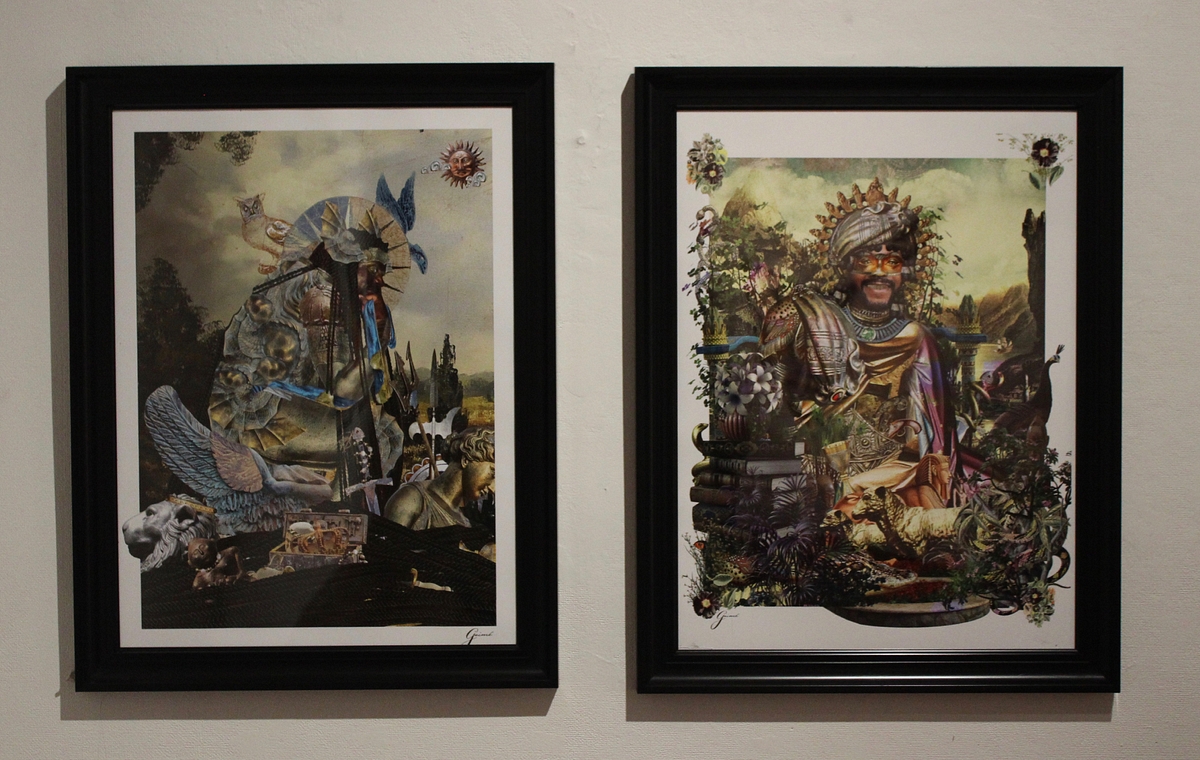
Greg Aimé
Sir MacArthur and Pope Francis
Greg Aimé’s Sir MacArthur and Pope Francis are already intricate enough from a visual perspective. They are riffs on, even explosions of, classic European portraiture. They are collages to get lost in, places where cultural signifiers blend and collide. They capture the scrum of history, the messy generation of culture, where suffering, celebration, experience and investigation commingle. Aimé then adds a layer for anyone with a device that can read a QR code; there’s music, narration, that gives more context, broadens and deepens the themes. The layers of aural and visual components are a statement in themselves. There’s always more to learn, always ways to dig deeper.
The pieces are part of “Truth in Three Colors,” a show curated by Kim Weston of Wábi Gallery, which “is inspired by legendary jazz artist Charles Mingus,” an accompanying note explains. “Truth cannot be bent. It can be interpreted, therefore be manipulated into something else, yet the foundation of the truth remains. The selected artists” — Aimé, Junior Charles, Tracie Cheng, Dooley‑O, Howard el-Yasin, Bud Glick, Leonard Harmon, Linda Vauters Mickens, and Aisha Nailah — “take a look at what is true from their gaze and social circumstances.”
The show is meant to tell a story, as the pieces “take you on a journey of birth and vulnerability, to love and healing. Suffering and sacrifice often balance between passion and possession while hope, loss and forgiveness often existing in the same space. These artists use sculpture, photography, spray paint, collage and various materials to transform narratives based in authenticity.” The show is also about personal social struggle and personal freedom: “Indigenous genocide, slavery, racism, Chinese immigration, family, separation, love of flowers, political power, dreams lands in the African diaspora, black matter, material, and the ability to release are a few topics to explore in the many frames of truth in this exhibition.” But it’s not a lecture either; viewers are invited to “bring your beliefs to the visual conversation.”

Junior Charles
King Me #1, #2, and #3.
Junior Charles’s pieces in the show lean more into the celebratory side of the exhibition. They are a statement of heritage, of the royalty inside, pointing to a rich and colorful history as well as a connection to nature.

Linda Vauters Mickens
Hunt and Kill, detail.
Linda Vauters Mickens’s installation, meanwhile, comes from a place of raw pain and protest. She gives her arresting sculpture of a screaming woman holding an automatic rifle a fuller treatment that fills an entire room of the gallery. With additional statues, writing on the wall, and streamers hanging from the ceiling, Mickens makes manifest the oppression and violence of police killings, and the anger and grief that flows from them.

Aisha Nailah
S.T.I.L.L. Life 5, 7, and 6.
A few of the artists make pieces using visual language that partakes of both abstract art and graffiti, whether it’s Aisha Nailah’s vivid circular pieces, Dooley-O’s stencil-like portraits streaked with tags, or Leonard Harmon’s kinetic SKIN, which takes the words some have used to describe skin and hair and puts them in a whirlwind. Together they mix the rarified art of museums and the art of the street; in their eyes, perhaps, those distinctions only matter in terms of money and access to opportunities for advancement, not in the art itself.

Howard el-Yasin
My Mother's Hose.
On the second floor of the gallery, things get both more abstract and more concrete. Howard el-Yasin stays true to the path of previous work in making a piece that feels both quite conceptual and almost literally visceral, to disconcerting and mesmerizing effect.

For a Split Second.
Meanwhile, as kinetic as they are, Tracie Cheng’s series of pieces offers a kind of soothing solace.

Then, one hallway and an entire second-floor room are taken up by photographs from Bud Glick, which comprise an exhibition within the exhibition. As an accompanying note explains, Glick’s photographs were part of a “larger documentation project” from the New York Chinatown History Project “that involved conducting oral histories, salvaging business artifacts, and mounting exhibitions.” The project was done because the project runners could see the neighborhood rapidly changing, and in a sense, see the ways that neighborhood is half-disappearing now. “Bud’s photographs show the people, details, and atmosphere of a very different Chinatown from today’s — one that had a bustling garment industry, a fading bachelor society, and a growing population of new immigrants.” QR codes allow viewers access to audio from interviews with the subjects of the photographs.
Glick’s absorbing photographs, in rich black and white, are sometimes portraits of individuals that, in the best style of documentary photography, always give their subjects their dignity. These are juxtaposed with images of people playing games on the street, unboxing produce to load into a grocery store, or working in enormous laundries and garment factories.
Glick’s sharp, deep dive into a microcosm that is already gone gives the other pieces in the exhibition an even wider context. All the pieces are connected by the sense of a search for meaning — for understanding who we are and what our place in the world is, while also understanding that both of those can change, any time.
“Truth in Three Colors” runs through April 30 at the Ely Center of Contemporary Art, 51 Trumbull St. Visit ECOCA’s website for hours and more information.